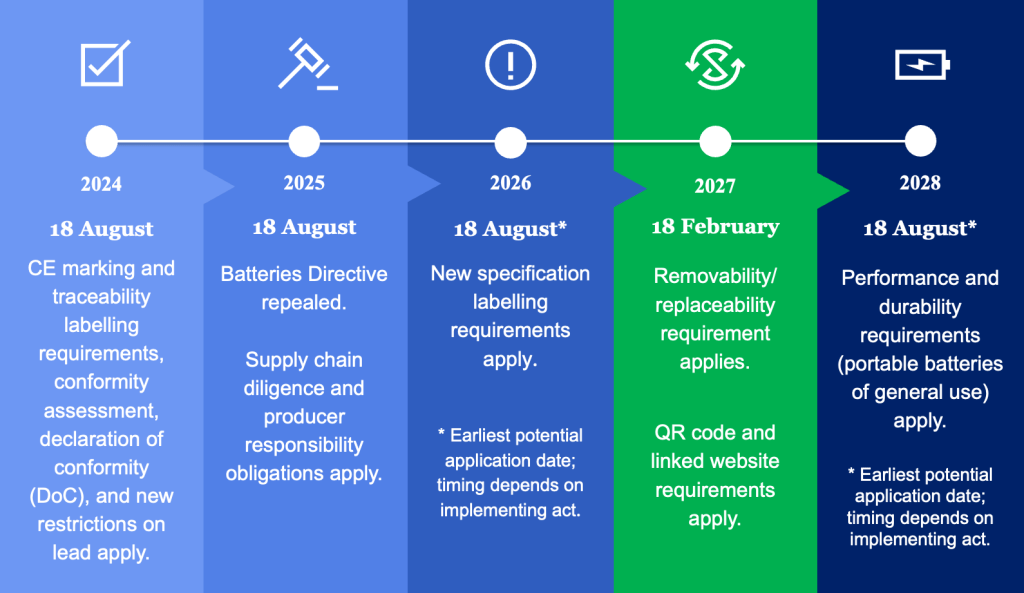The European Union Batteries Regulation 2023/1542 started applying in August 2024, and it represents a major change for anyone who manufactures, imports, or sells products containing batteries (or stand-alone batteries).
The EU Batteries Regulation establishes a raft of new obligations, including for the design, conformity assessment and labelling of products, as well as in respect of supply chain due diligence, audit and online disclosures. With new requirements phased in from 18 August 2024, most product stakeholders need to take immediate action to ensure they comply with the requirements.
In this new Productwise miniseries, we’ll be summarising the requirements of the EU Batteries Regulation and breaking down the new compliance obligations into the following topic areas:
- Scope and timeline for compliance.
- Conformity assessment, CE marking and substance restrictions.
- Labelling.
- Designing for repair – removability and replaceability.
- Supply chain due diligence requirements.
- Producer responsibility obligations.
- Penalties and risks of noncompliance.
This post is Part 1 in the series, and it sets out the scope of the new legislation and the timeline for compliance. Watch this space for more on the rest of these topics, and if you have questions in the meantime, please reach out to the Cooley products team.
Which batteries are in scope?
All batteries are in scope, save for a few very narrow exemptions for batteries connected with the protection of security interests, military purposes or intended to be sent into space.
Importantly, this includes both stand-alone batteries and batteries incorporated into products. The Batteries Regulation establishes certain requirements for the battery itself (e.g., conformity assessment, CE marking and labelling) and other requirements for products that incorporate batteries (e.g., a requirement to design for easy removal and replacement of the battery by an end user).
There are varying requirements under the Batteries Regulation, depending on the type of battery. For product manufacturers, the key types of battery to be aware of will be:
- Portable batteries, which is the category of batteries in most consumer electronic devices
- Portable batteries of general use, which is a subset of portable batteries in common formats (e.g., AA, button cell).
- Light means of transport (LMT) batteries, which are commonly used in electric bicycles and other forms of light transportation.
- Starting, lighting and ignition (SLI) batteries, which are commonly used in (non-electric) vehicles to start the engine and power certain vehicle systems.
- Electric vehicle (EV) batteries that provide electric power for traction in hybrid or electric vehicles of categories M, N, or O.
- Industrial batteries, which are specifically designed for industrial uses or batteries of more than 5 kilograms that are not an EV, LMT, or SLI battery.
- Stationary battery energy storage systems, which store and deliver energy to the grid or end users.
Who has obligations under the Batteries Regulation?
Manufacturers, importers, and distributors who supply batteries or products containing batteries in the EU are subject to obligations, which apply to online and in-store business-to-consumer and business-to-business sales.
Can I rely on my battery supplier to ensure compliance?
Manufacturers of final products will be legally responsible for the compliance of the batteries they contain. This means that product manufacturers will need to work closely with their battery suppliers to ensure that batteries comply with the new requirements set out in the law, or risk facing penalties that could include fines and restrictions on the sale of products.
What do I have to comply with if I am in scope?
Manufacturers of products containing batteries will need to comply with the following requirements:
- Design portable batteries to be readily removable and replaceable by end users using commonly available (or provided) tools during the lifetime of the product. (There are very limited exemptions to this requirement.)
- Ensure a conformity assessment has been carried out, batteries have been marked with the CE mark and technical documentation, and a declaration of conformity has been drawn up.
- Batteries must be labelled with a range of new information and a QR code which links to certain information on a webpage.
- Ensure that batteries comply with substance restrictions (for all batteries) and performance and durability requirements for portable batteries of general use.
Importers and distributors will have their own obligations to ensure that the manufacturer has complied with these obligations and act with due care in relation to these requirements, respectively.
In addition, manufacturers and importers of batteries and products containing batteries must comply with new supply chain due diligence obligations. These include developing a due diligence policy and having this policy verified by a third-party notified body. Compliance must be audited annually, due diligence policies incorporated into contacts with suppliers, and annual reports on compliance published on the manufacturer or importer’s website. Manufacturers, importers and distributors also must comply with new producer responsibility requirements.
When do the new requirements apply?
As shown in the graphic below, there will be phased implementation of the requirements under the Batteries Regulation.

